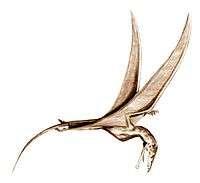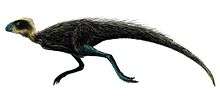Megalosaurus cloacinus
| "Megalosaurus cloacinus" Temporal range: 198–196 Ma | |
|---|---|
| Scientific classification | |
| Kingdom: | Animalia |
| Phylum: | Chordata |
| Class: | Reptilia |
| Superorder: | Dinosauria |
| Order: | Saurischia |
| Suborder: | Theropoda |
| (unranked): | Neotheropoda |
| Infraorder: | ?Tetanurae |
| Genus: | Indeterminate Quenstedt, 1858 |
| Species | |
| |
| Synonyms | |
|
Megalosaurus | |
"Megalosaurus cloacinus" is a taxon of early theropod dinosaur living during the Hettangian stage of the Early Jurassic of what is now Europe. The fossils of "M. cloacinus", consisting of the type specimen SMNS 52457, were found on the Upper Keuper of Germany. While a complete skeleton has not yet been discovered, "Megalosaurus cloacinus" was likely a bipedal predator.
Description
"M. cloacinus" was a medium-sized theropod. Adults possibly had a body length of approximately 6 m (20 ft).
French tooth
A destroyed fossil tooth from the Calcaire de Valognes of France was attributed to M. cloacinus, but only the German material is considered valid due to the destruction of the fossils and the absence of new material.
Taxonomy and classification
Originally, "M. cloacinus" was classified as a new species of the genus Megalosaurus. It is now considered an invalid species and potentially a new taxon, possibly one of the earliest known tetanuran theropods. Modern depictions classified them related to the early neotheropod Zupaysaurus.
Below is a cladogram based on the phylogenetic analysis conducted by Sues et al. in 2011, showing the affinities of the closely related Zupaysaurus:
| Theropoda |
| |||||||||||||||||||||||||||||||||||||||||||||||||||||||||||||||||||||
| |
Paleoecology
Provenance and occurrence
"M. cloacinus" was discovered in the Exter Formation, of the Upper Keuper, a lithostratigraphic subgroup of the Keuper in the Germanic Trias. The lithostratigraphic unit is underlain by the Middle Keuper subgroup, while also being overlain in the North German Basin by the Lias and in the South German Basin by the Black Jurassic. The Exter Formation has been interpreted as an ancient forest, home to several types of early sauropodomorph dinosaurs (including Plateosaurus, Efraasia , and a taxon related to Antetonitrus which is possibly the earliest true European sauropod) thatwhich shared the same paleoenvironment. It is recognized as one of the earliest known faunal assemblages dominated by dinosaurs, which comprised 43% of the number of tetrapod species known from the site. The non-dinosaurs that inhabited this locality included pseudosuchians, therapsids like Cynodontia, other early reptiles, and possible protosuchids.
References
- M. T. Carrano, R. B. J. Benson, and S. D. Sampson. 2012. The phylogeny of Tetanurae (Dinosauria: Theropoda). Journal of Systematic Palaeontology 10(2):211-300 [M. Carrano/M. Carrano]



